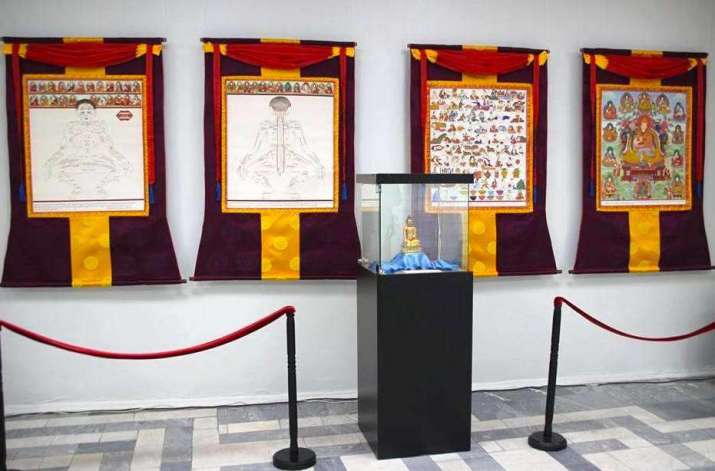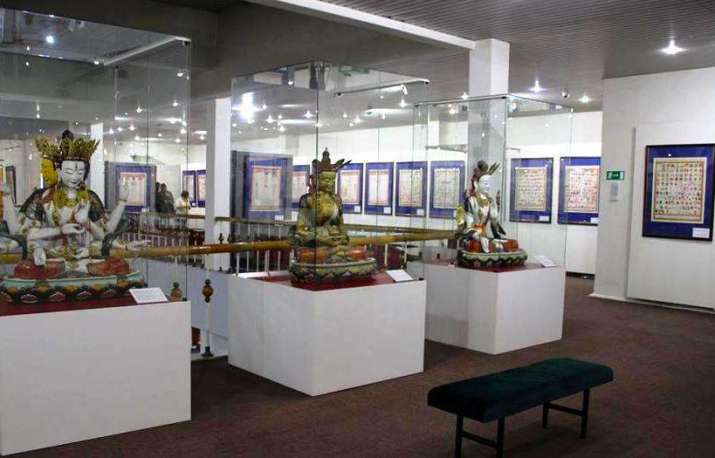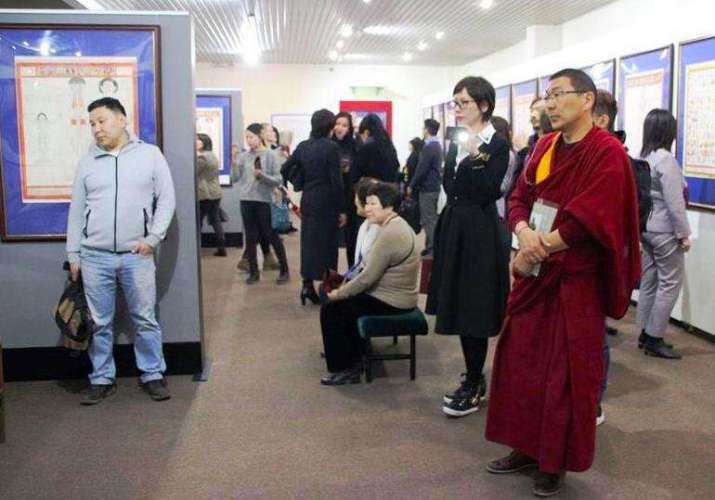
SOFIA—An exhibition titled “The Atlas of Tibetan Medicine: Radiance of the Blue Beryl Buddha,” opened on 29 March at the Museum of History of Buryatia. The exhibition is the renowned museum’s main event for 2019 and commemorates the 20th anniversary of the first exhibition of The Atlas of Tibetan Medicine in the Russian republic.
The atlas is one of only three copies of the 17th century Tibetan original in existence—the other two copies are kept in the ancient Tibetan capital Lhasa. The Atlas of Tibetan Medicine consists of 76 sheets in the style of thangkas, painted with mineral pigments on linen canvas, and contains some 10,000 drawings depicting aspects of Tibetan medicine—theory, the basics of clinical medicine, treatment methods, practitioner ethics, the training of doctors, and so on.
The anniverasy event features not only a display of the pages of the medical atlas but also a history of Tibetan treatises, emphasizing the role of Buryat lamas, who made significant contributions to the study and practical adaptation of Tibetan medicine in Buryatia.
The exhibition was opened by Nikolai V. Emonakov, deputy minister of culture; Boris Bazarov, director of the Institute for Mongolian, Buddhist, and Tibetan Studies; Geshe Dybryl Dashibaldanov, rector of the Buddhist University in Ivolginsky Datsan; and Alexander Kocharov, renowned thangka scholar.
The Atlas of Tibetan Medicine is a collection of illustrations to the main texts of Tibetan medicine (Sowa-Rigpa, the science of healing) known as The Four Tantras (Gyushi), and to their commentary The Blue Beryl (Vaidurya Ngonpo).* The Four Tantras is comprised of Tibet’s oldest medical texts, and is considered a compendium of the wisdom of the Medicine Buddha. They were composed and compiled by Yuthok Yonten Gonpo the Elder (708–833) in the eighth century and later re-edited by Yuthok Yonten Gonpo the Younger (1126–1202) in the 12th century.

The Blue Beryl is a commentary on The Four Tantras, written around 1720 by Desi Sangye Gyatso (1653–1705), regent of the Fifth Dalai Lama, Ngawang Lobsang Gyatso (1617–82), who founded the medical school of Men-Tsee-Khang in 1694.
The atlas was created over a period of more than 16 years by a group of medical doctors and professional artists working under the leadership of Desi Sangye Gyatso. It begins with a mandala of Medicine Buddha and the transmission of his teachings, followed by the causes of diseases, diagnosis, treatment, human physiology, natural objects that can be used as medicines (such as herbs, minerals, and animal products), human embryology, dream prognosis, personal conduct, and diet.
In an article titled “Tibetan Medical Illustrations from the History Museum of Buryatia, Ulan Ude,” published in Asian Medicine 3 in 2007, author Natalia Bolsokhoyeva notes that the atlas was brought from Tibet to Buryatia by Agvan Dorjiev (1854–1938), one of the most influential Buddhist figures in the history of Tibet and Russia, at the beginning of 20th century.
The article also offers two other versions of the events surrounding how the copy of The Atlas of Tibetan Medicine was brought to Buryatia, connected with the Buryat scholar, Prof. Bazar Baradiin (1878–1937), who visited the traditional Amdo region of Tibet, and the Buryat lama and physician Sherab Sunueyv (1860–1930), who studied medical sciences at Serktog Manba Datshan.
In August 1999, the first exhibition with all 76 sheets of the atlas opened at the Museum of History of Buryatia. Now, 20 years later, the exhibition of Tibetan medical treasures continues to intrigue many Buryat people and guests of the Buddhist republic.

The Museum of History of Buryatia was founded in 1923 and is one of the oldest in Siberia. In 1958, it was named after the famous Buryat ethnographer M. Khangalov. The halls of the museum are home to more than 100,000 artifacts and include a unique collection of Buddhist art.
* Vaidurya, used both in Sanskrit and Tibetan languages, is identified with the mineral beryl, which has different colors. When used in reference to the Medicine Buddha, it is blue. Vaidurya is also identified with lapis lazuli. Ngonpo means “blue” in Tibetan.
See more
Выставка «Атлас тибетской медицины. Сияние бериллового Будды» Наука. Духовность. Миф.
Уникальный памятник буддийского искусства представили в Национальном музее Бурятии












